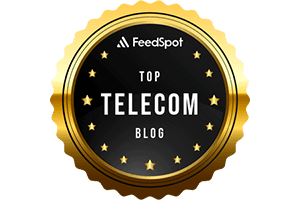Uncategorized
Lumen, Google and Microsoft create ExaSwitch™ – a new on-demand, optical networking ecosystem
Lumen Technologies today announced a new network interconnection ecosystem called ExaSwitch™, created in collaboration with Google and Microsoft. This platform empowers organizations with high bandwidth needs to route their traffic dynamically and quickly between networks, and without third-party intervention.
This ExaSwitch project was created by the initial participants to route traffic between large internet and cloud networks. Early adopters include Lumen, Google Cloud, Microsoft Azure and an additional large cloud provider. The ExaSwitch ecosystem will continue to strengthen as additional participants join, making it easier to automate, scale and manage capacity between the members.
ExaSwitch users will be able to connect their edge sites, data centers and central offices to the platform. With a self-service portal, they can set up connections in 400G increments, which can then be consumed on demand in 100G increments. Lumen, the administrator for the initial ExaSwitch deployments, will be responsible for installing optical hardware at the location of each participant. Users can choose their own fiber source for connecting into ExaSwitch, which they can do either via the self-service portal or an application programming interface (API) portal managed by Lumen.
“The days of slow, legacy cross connects are over; ExaSwitch is the future of network interconnections,” said Andrew Dugan, Chief Technology Officer, Lumen. “Large network backbones no longer need a physical location to connect. Instead, optical switching will be used to establish high-capacity optical links between metro sites. And it’s so much more than just internet peering; it’s an on-demand network connection for quickly deploying needed capacity across all types of data traffic exchanges.”
“We like the ease, speed and cost efficiency of performing interconnects to network partners directly from our main sites,” said Steve Walter, Global VP of Network Operations, Google. “ExaSwitch provides an agile, on-demand platform using proven technology that achieves that.”
“Creating a geographically distributed yet automated interconnection platform creates so many options to improve connectivity, resiliency, and speed to add capacity on to one’s network,” said Frank Rey, Partner, Azure Networking, Microsoft. “We are pleased at the opportunity ExaSwitch has to change the interconnection ecosystem.”
The ExaSwitch administrator will install optical hardware at the preferred location for each participant, who will choose their own fiber source for connecting into ExaSwitch. When two participants agree to connect, they can join quickly through self-provisioning, or an API portal driven and managed by the administrator. The real-time capacity deployment allows them to easily order, modify and delete services as needed. Lumen is acting as the administrator for the initial deployments.
Key benefits:
- Participants use a self-service portal to configure and turn up connectivity with other participants much faster than they can now.
- Connections are set up in 400G increments and can be consumed on demand in 100G increments, with each site capable of up to 25.6 Tbps of optical cross connects.
- Participants will have the ability to connect their edge sites, data centers and central offices in major markets to gain diversity and save costs on cross connects.
“The ExaSwitch optical switching platform is an innovative on-demand ecosystem for automating, scaling and managing high-value interconnect services,” said Courtney Monroe, VP of Telecommunications Research for IDC. “It is poised to disrupt legacy manual platforms, as well as the way enterprises, and the IT ecosystem interconnect, procure and manage interconnectivity.”
Lumen is currently operating the ExaSwitch platform in three of the largest US interconnection hubs – Chicago, Dallas and Virginia – with plans to expand to all major markets in North America with large internet hubs. ISPs, cloud providers, large content providers and enterprises can go to http://exaswitch.net to learn more about ExaSwitch and how to join this growing ecosystem.
Lumen earlier this year completed 400G wavelength upgrades covering 70 U.S. markets. The company’s SVP of Core Network Solutions told Fierce Telecom in January a single 400G wave requires only two cross-connects, which offers “huge cost benefits for the customers.”
About Lumen Technologies:
Lumen connects the world. We are dedicated to furthering human progress through technology by connecting people, data, and applications – quickly, securely, and effortlessly. Everything we do at Lumen takes advantage of our network strength. From metro connectivity to long-haul data transport to our edge cloud, security, and managed service capabilities, we meet our customers’ needs today and as they build for tomorrow. For news and insights visit news.lumen.com, LinkedIn: /lumentechnologies, Twitter: @lumentechco, Facebook: /lumentechnologies, Instagram: @lumentechnologies, and YouTube: /lumentechnologies.
SOURCE: Lumen Technologies
References:
https://www.fiercetelecom.com/telecom/lumen-google-microsoft-unveil-new-optical-networking-platform
ACSI report: AT&T, Lumen and Google Fiber top ranked in fiber network customer satisfaction
Lumen to provide mission-critical communications services to the U.S. Department of Defense
Dell’Oro: Optical Transport market to hit $17B by 2027; Lumen Technologies 400G wavelength market
Lumen: DDOS attacks on the rise with telcos accounting for 76% in 1Q-2022
FT: A global satellite blackout is a real threat; how to counter a cyber-attack?
by John Thornhill, Innovation Editor at the Financial Times (FT)
What if the satellite communications networks encircling our planet ever go down? Mobile phones will stop working, navigation systems will crash, television screens will go dark and financial transactions will fail.
The three most likely ways this might happen are: an intense geomagnetic storm resulting from a solar flare like that which occurred in 1859, known as the Carrington event; a cascading collision of space debris, called the Kessler effect; or a deliberate cyber attack.
On Sunday, a SpaceX rocket blasted off from Cape Canaveral with a special payload designed to reduce the last of those dangers. On board was a US government Moonlighter satellite, described as “the world’s first and only hacking sandbox in space.”
Once the satellite is deployed, five so-called “white hat” — or ethical — hacking teams at the Hack-A-Sat 4 competition in Las Vegas will try to hijack the Moonlighter and win a $50,000 prize for exposing its vulnerabilities.
“With Moonlighter, we’re trying to get in front of the problem before it is a problem,” one project leader told The Register.
Last year, on the day Russia invaded Ukraine, hackers launched a malware attack against Viasat’s KA-SAT satellite. They temporarily disrupted the communications of thousands of broadband users in Ukraine, as well as in Poland, Italy and Germany, where 5,800 wind turbines were also affected.
“We are all aware that the first ‘shot’ in the current Ukraine conflict was a cyber attack against a U.S. space company,” Kemba Walden, America’s acting national cyber director, has said.
Leaked CIA intelligence, reported by the Financial Times this year, warned that China was also building sophisticated cyber weapons to “deny, exploit or hijack” enemy satellites. The U.S. has not revealed its own offensive capabilities in this domain. But it is not only Chinese spy balloons Washington is worrying about. Whereas space used to be solely the domain of nation states, private companies are increasingly dominating the game as launch costs fall and satellites shrink in size.
Last year, the U.S. launched 1,796 objects into space, 32 times more than in 2000. The lines between the military and civilian have also blurred as a result of dual-use applications, such as global positioning systems, making commercial satellites a target. And because of the difficulties of fixing satellites in space, designers add a lot of back-up parts, increasing the “attack surfaces” that hackers can exploit.

Viasat says it has learnt lessons from last year’s attack and has strengthened its defences. Basic cyber hygiene is essential in every link in the communications chain (the hackers accessed a misconfigured ground-based virtual private network appliance). Constant vigilance is required: the US company has been persistently attacked since the war began. And rapid response teams must be ready to re-establish control if a system is compromised.
“Anybody who claims perfect security is either lying or they do not know what they are talking about,” Craig Miller, Viasat’s president of government systems, tells me. “You have to be able to respond very quickly.”
There are three main ways to hack a satellite, according to James Pavur, a cyber security engineer at Istari, a US start-up. The first target is ground infrastructure, the most accessible attack surface but usually the best protected. Then, hackers can aim to intercept wireless communications between ground stations and the satellites — or spoof them. The third, and hardest, approach is to go after the “bird in orbit” by building, or exploiting, security backdoors in satellite components. So operators must secure their entire supply chain.
Most hacking attacks are hard to trace. Only four countries have the known capability to take out a satellite with a rocket — the US, China, India and Russia — although such attacks risk triggering the Kessler effect. But anyone from anywhere at any time can hack software. White hat hackers are a particularly valuable community in helping to secure critical satellite infrastructure, argues Pavur.
“There is a mindset of security through obscurity. But a sufficiently motivated adversary will find an ‘exploit’,” he says. Far better to discover those vulnerabilities first and fix them rather than trying to shelter in obscurity. The idea of crowdsourcing security sounds like an oxymoron. But white hat hackers have won round sceptics over the past decade. As software developers say: “Given enough eyeballs, all bugs are shallow.” That rule may even apply in space.
Write to: [email protected]
References:
https://www.ft.com/content/d5df1e81-f126-4a48-9a42-5b4aca842dcb
https://www.lse.ac.uk/ideas/projects/space-policy/publications/Cyberattacks-on-Satellites
https://interactive.satellitetoday.com/the-growing-risk-of-a-major-satellite-cyber-attack/
Reuters: Telcos draft proposal to charge Big Tech for EU 5G rollout; Meta offers a rebuttal
Big tech companies accounting for more than 5% of a telecoms provider’s peak average internet traffic should help fund the rollout of 5G and broadband across Europe, according to a draft proposal by the telecoms industry. The proposal is part of feedback to the European Commission which launched a consultation into the issue in February. The deadline for responses is Friday.
Alphabet’s Google, Apple Facebook-owner Meta, Amazon, Netflix and TikTok would most likely be hit with fees, according to industry estimates. Google, Apple, Meta, Netflix, Amazon and Microsoft together account for more than half of data internet traffic.
The document, which was reviewed by Reuters and has not been published, was compiled by telecoms lobbying groups GSMA and ETNO. They represent 160 operators in Europe, including Deutsche Telekom, Orange, Telefonica and Telecom Italia. Telecom operators have lobbied for years for leading technology companies to help foot the bill for 5G and broadband roll-out, saying that they create a huge part of the region’s internet traffic. This is the first time they have tried to define a threshold for who should pay.
“We propose a clear threshold to ensure that only large traffic generators, who impact substantially on operators’ networks, fall within the scope,” the draft stated. “Large traffic generators would only be those companies that account for more than 5% of an operator’s yearly average busy hour traffic measured at the individual network level,” it said. The European Commission declined to comment.

Meta on Wednesday urged Brussels to reject any proposals to charge Big Tech for additional network costs. In a Facebook blog post, Markus Reinisch, Meta’s VP for Public Policy for Europe, described potential fees as a “private sector handout for selected telecom operators” that would disincentivize innovation and investment, and distort competition. “We urge the Commission to consider the evidence, listen to the range of organizations who have voiced concerns, and abandon these misguided proposals as quickly as possible,” he said. Here are Meta’s takeaways:
- Network fee proposals misunderstand the value that content platforms bring to the digital ecosystem.
- We support the Commission’s goal of “ensuring access to excellent connectivity for everyone,” but network fee proposals will hurt European consumers and businesses.
- We urge the Commission to consider the evidence, listen to the range of organizations who have voiced concern, and drop these proposals.
References:
Network Fee Proposals Will Ultimately Hurt European Businesses and Consumers
https://www.euractiv.com/section/5g/news/eu-telcos-call-for-big-tech-to-share-5g-network-costs/
GSMA: Europe’s 5G rollout is too slow at 6% of mobile customer base
European telcos need to address very high 5G energy consumption
Strand Consult: Market for 5G RAN in Europe: Share of Chinese and Non-Chinese Vendors in 31 European Countries
MTN Consulting: Satellite network operators to focus on Direct-to-device (D2D), Internet of Things (IoT), and cloud-based services
Satellite network operators are being forced to expand their addressable markets in the near term, due to several factors: rising competition, with the emergence of players such as SpaceX along with several upstarts including AST SpaceMobile and Lynk. A difficult funding climate resulting from a grim economic outlook and rising interest rates is a challenge. There are also market concentration risks arising from the current focus on satellite broadband internet.
To address these challenges, satellite network operators are raising stakes in new pursuits and developing new offerings. MTN Consulting expects three new potential addressable markets to provide transformational opportunities for satellite operators in the next 2-4 years. These include Direct-to-device (D2D), Internet of Things (IoT), and cloud-based services.
Looking at these market opportunities, a thought may arise whether satellite operators are trying to disrupt the traditional telecom market. But the reality is that telcos will continue to be the primary service provider for wireless access. Telcos are also going to benefit from partnerships with satellite operators as they will aid in providing an enhanced experience for telco customers, reinforced by ubiquitous coverage. For satellite operators though, navigating the regulatory hurdles and ensuring constant capital flow are key concerns; several players from the current herd will vanish in the next 3-5 years.
The battle for space based Internet gained momentum in the year 2022 as several satellite operators, notwithstanding their size and years of operations, shifted gears with the launch of commercial broadband internet through low earth orbit (LEO) satellites. The space rush, aided by the advancement in satellite development and large-scale manufacturing, witnessed the sudden surge in large fleets of LEO satellites being deployed in recent years, as shown in Figure 1. As of May 2022, about 4,700 active LEO satellites are girdling the planet; that’s 16x the number of active LEO satellites deployed a decade ago.
Separately, MTN found that a number of large telcos have high debt, low margins, and/or weak top line growth, and may have to curtail spending in 2023-2024 in order to cope with this reality. In particular:
- Total telco debt in 4Q22 was $1.14 trillion, 17% due in next year
- Software capex as a % of revenues was 1.9% in 2022, up a bit from 1.8% in 2021.
- Spending on acquisitions amounted to 0.5% of revenues in 2022, the lowest figure since 2012.
- At the industry level, the ratio of net debt to EBITDA in 2022 was 1.9, a bit up from 2021 but down from 2020.
- A number of large telcos face short-term debt levels over 30% of total debt
- Average margins for the industry in 2022 disappointed: free cash flow margin for the telco industry in 2022 was 11.4%, down from 12.6% in 2021; EBITDA margin was 33.7% (2021: 34.0%), and EBIT margin was 14.4% (2021: 14.9%).
References:
Satellite players bet on direct-to-device (D2D), IoT, and cloud for next big liftoff
Omdia Surveys: PON will be a key part of network operator energy reduction strategies
Omdia (owned by Informa) surveys have found a “very high” number of telcos regarded PON as a key part of their energy savings programs. Omdia’s chief analyst Julie Kunstler said PON technology is fiber-asset efficient, easy to upgrade, and highly secure.
Speaking at a Light Reading webinar Thursday, Kunstler said another large cohort of network operator execs said they believed PON would play some role in their energy reduction strategies. “PON is energy efficient and this is definitely gaining attention.” Kunstler said “a very strong movement” by operators was underway toward next gen PON, in particular XGS PON. “But perhaps more importantly, PONs are also supporting other types of customers and applications.” She also noted PON technology was fiber-asset efficient, easy to upgrade, highly secure and allowed operators to choose when to upgrade. But she cautioned that in many telcos PON faced organizational obstacles because of the belief that it was for consumer services only and because of the silos between residential and business.
Anuradha Udunuwara, a senior enterprise solutions architect at Sri Lanka Telecom, said energy costs had become a bigger concern in the past 12 months following sharp hikes in power tariffs. He agreed that PON “definitely has an advantage… it is passive, so there is no energy consumption there.”
Udunuwara described PON as an “architectural option” that could support FTTX deployment. He said it was a myth about PON that it was for FTTH only. “It’s not confined to any of the variations of FTTX.” He expected that in the long run services would converge on to a single access technology.
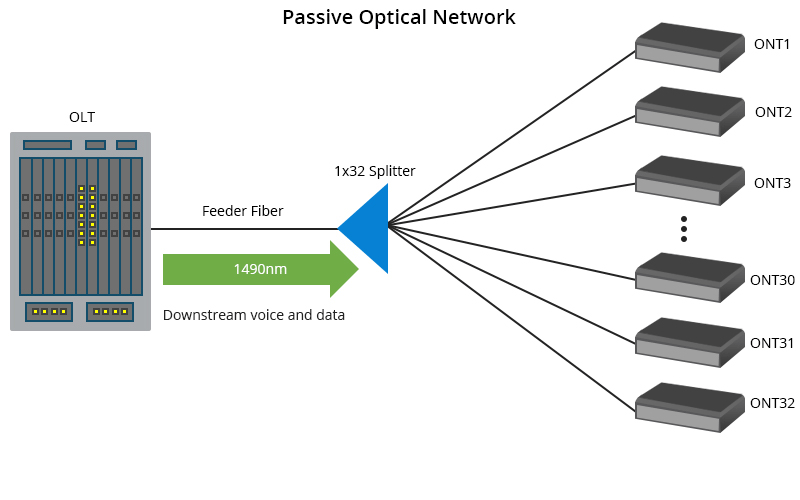
“Oftentimes, sales and marketing teams don’t feel comfortable about PON, simply because they don’t understand it,” Kunstler said. “Many believe its point to multipoint topology is for residential only and that it’s simply best effort and there’s no technical ability to support enterprise services.”
“A lot of education is needed within some operators to explain to the sales and marketing team that PON is not just best effort and that you can actually commit to rates,” she pointed out.
“Not all enterprises need point to point. They don’t all need their own dedicated fiber, and many of them really don’t want to have to pay for dedicated fiber.”
Kunstler said selling business services over PON increased the ROI over that access infrastructure. “With 10G PON, you can easily support one gig symmetrical, two gig symmetrical five gig symmetrical and so forth, and 50 GPON, which will be here within a couple of years, can even support more bandwidth.
By using that optical distribution network for more than just residential, operators were already moving to a converged access approach. “You have more revenues over a single access network. You have a single network to upgrade. You have improved optics and you have improved energy savings.”
References:
Dell’Oro: XGS, 25G, and Early 50G PON Rollouts to Fuel Broadband Spending
AT&T to deploy FTTP network based on XGS-PON in Amarillo, TX
ZTE PON ONT obtains EasyMesh R3 certification from WiFi Alliance
Dell’Oro: PONs boost Broadband Access; Total Telecom & Enterprise Network Equipment Markets
Omdia: Consumer Telco Opportunity Challenged by Global Tech Giants
Market research firm Omdia (owned by Informa) says all growth areas for telcos will experience significant competition from hyperscalers – specifically the global tech giants Google, Amazon, Meta/Facebook, and Apple.
Omdia’s Quantifying the Consumer Telco Opportunity – 2023 report is an in-depth report providing analysis and insights drawn from Omdia’s related data tools as well as individual operator case studies. The market research firm says that other than core fixed-line and mobile data services, almost all of the potential growth for telcos in the consumer sector over the next few years will come from ‘non-traditional categories. Those include video streaming, digital gaming, streaming music, and smart home (whatever that means).
“Service providers must look beyond data and diversify into adjacent digital markets to enable continued growth of their telco consumer businesses,” said Omdia’s Jonathan Doran. “Many have already invested in TV and online video entertainment, but there are other fast-growing markets telcos can also explore. Adopting the right go-to-market strategy and business model for each individual service area will be critical to striking the balance between achieving market success and mitigating financial risk. In many areas, telcos will need to accept that competing head-on is unrealistic and developing partnerships with such players is not only more pragmatic but will also serve to strengthen their own products and brands” observes Doran.
“Omdia’s Digital Consumer Operator Strategy Benchmark shows that the more service providers actively invest in a given service area – including through partnerships – the bigger market impact they have, which in turn better positions them to take a bigger slice of overall market revenue”
Big tech is already there and doing a decent job of selling all these digital goodies direct to consumers without the help of operators. Every time telcos have tried to compete directly in adjacent markets is has all gone horribly wrong so, as well as picking their fights more carefully, they are advised to consider an ‘if you can’t beat em, join em’ approach.
“In many areas, telcos will need to accept that competing head-on is unrealistic and developing partnerships with such players is not only more pragmatic but will also serve to strengthen their own products and brands,” said Doran. “Omdia’s Digital Consumer Operator Strategy Benchmark shows that the more service providers actively invest in a given service area – including through partnerships – the bigger market impact they have, which in turn better positions them to take a bigger slice of overall market revenue.”
The Omdia chart below illustrates product types by growth potential (horizontal axis), relevance to the Communications Service Provider (CSP) core proposition (vertical axis) and forecasted relative 2027 market size. As you can see, most consumer digital products are pretty far from the CSP core proposition, but Omdia forecasts they will collectively amount to a $500 billion market by 2027. How much of that will find its way into the pockets of telcos as a result of partnering with Big Tech remains to be seen, but even a small fraction is better than nothing.

Amazon, Microsoft and Google are not only three of the biggest players in the digital consumer space, they also dominate the public cloud market, which network operators are constantly urged to turn to for its efficiencies and flexibility. It’s possible to imagine a time most of what we get from and operator is actually supplied, and monetized, buy one of a small number of hyperscalers. It’s not clear whether that represents a positive development for the telecoms industry.
References:
https://telecoms.com/521154/study-highlights-increasing-dependence-of-operators-on-hyperscalers/
IEEE Techblog recognized by Feedspot!
The IEEE ComSoc Techblog was voted #2 best broadband blog:
https://blog.feedspot.com/broadband_blogs/
2. The IEEE ComSoc Technology Blog
 Piscataway, New Jersey, US
Piscataway, New Jersey, US
Featuring the latest in breaking telecom/networking news and analysis, the IEEE ComSoc blog is written by several expert bloggers. IEEE Communications Society is a global community of professionals with a common interest in advancing all communications and networking technologies.
Also in Telecom Blogs
techblog.comsoc.org+ Follow
…………………………………………………………………………………………………
..and #13 best telecom blog in the world:
https://blog.feedspot.com/telecom_blogs/?_src=alsoin
Many thanks to Vinny Rodriquez and Khanh Luh for making our blog so successful!
ABI Research: Major contributors to 3GPP; How 3GPP specs become standards
Three large network equipment vendors (Huawei, Ericsson, and Nokia) have been leading in both the number of contributions and approved contributions for 5G technologies to The 3rd Generation Partnership Project (3GPP). This is particularly the case with specifications related to User Equipment (UE) specifications and functionalities that are developed under RAN1, RAN2, RAN4, RAN5, SA2, SA3, and CT1 Working Groups (WGs).
Editor’s Note:
The 3GPP Organizational Partners (OP) are the seven Standards Developing Organizations (SDOs) – from China, Europe, India, Japan, Korea and the United States. The OPs are:
ARIB The Association of Radio Industries and Businesses, Japan
ATIS The Alliance for Telecommunications Industry Solutions, USA
CCSA China Communications Standards Association
ETSI The European Telecommunications Standards Institute
TSDSI Telecommunications Standards Development Society, India
TTA Telecommunications Technology Association, Korea
TTC Telecommunication Technology Committee, Japan
Participation in 3GPP is made possible by companies and organizations becoming Individual Members (IM) of one of the OPs.
- 3GPP specifications are not standards, they have no legal standing. They become “official” standards once one or more of the OPs transposes them, as ETSI has done many times.
- 3GPP specs become ITU-R recommendations when they are submitted to ITU-R WP5D by ATIS, discussed and agreed upon, then sent to WP5 plenary in November for final approval. That procedure was followed to create the ITU-R M.2150 recommendation which features 5G-NR.
……………………………………………………………………………………………………………………………………………………………………………………………………………….
The list of the most active companies within 5G 3GPP standards is listed in the table below:
| Top Ranked by Total Contributions | Approved Contributions | Total Contributions | Company Category |
| Huawei | 15,266 | 43,753 | Incumbent Infrastructure Vendor (End-to-End) |
| Ericsson | 11,601 | 36,375 | Incumbent Infrastructure Vendor (End-to-End) |
| Nokia | 7,553 | 23,112 | Incumbent Infrastructure Vendor (End-to-End) |
| Qualcomm | 5,523 | 18,471 | Chipset |
| Samsung | 3,548 | 16,464 | Incumbent Infrastructure Vendor (End-to-End) |
| ZTE | 3,415 | 15,291 | Incumbent Infrastructure Vendor (End-to-End) |
| Intel | 2,151 | 10,770 | Chipset |
| LGE | 1,396 | 10,139 | Handset/UE Vendor |
| CATT | 1,934 | 9,792 | Government/Institution/SDO/Academics |
| vivo | 1,205 | 8,367 | Handset/UE Vendor |
| MediaTek | 1,848 | 7,766 | Chipset |
Source: ABI Research

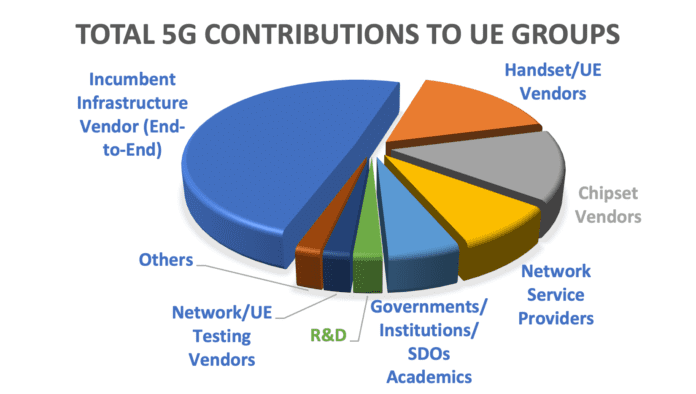
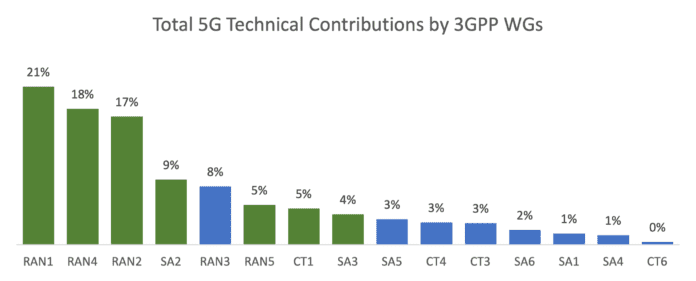
Key Takeaways:
- Counting contributions alone is insufficient to identify leaders in 3GPP standardization processes. However, it is a crucial step in recognizing active contributors and identifying innovation.
- More than 400 companies from the industry have participated in 3GPP standardization; however, only a handful of companies are consistently active in driving 3GPP 5G standards.
- Huawei, Ericsson, and Nokia have, so far, been leading in both the number of total and approved contributions for 5G technologies to 3GPP.
- Network infrastructure vendors are significantly more active than any other company categories, followed by handset vendors, chipset vendors, network service providers, and government research institutions.
- UE-related WGs (i.e., RAN1, RAN2, RAN4, RAN5, SA2, SA3, and CT1) take 80% of total contributions. RAN1, RAN2, RAN4, and SA2 are the most important WGs, impacting the entire mobile industry and receiving massive interest.
References:
https://www.3gpp.org/about-us/partners
ITU-R M.2150-1 (5G RAN standard) will include 3GPP Release 17 enhancements; future revisions by 2025
Busting a Myth: 3GPP Roadmap to true 5G (IMT 2020) vs AT&T “standards-based 5G” in Austin, TX
Dell’Oro: Worldwide Telecom Equipment Market Growth +3% in 2022; MTN: +2% Network Infrastructure Growth in 2022
by Stefan Pongratz, VP Dell’Oro Group
Following four consecutive years of modest telecom equipment growth across the six telecom programs tracked at the Dell’Oro Group, preliminary findings show that the aggregate telecom equipment market moderated somewhat from the 8% revenue increase in 2021 to 3% year-over-year (Y/Y) in 2022.
Looking back at the full year, the results were slightly lower than the 4% growth rate we projected a year ago going into 2022. In addition to more challenging comparisons in the advanced 5G markets and the supplier exits in Russia, the strengthening USD weighed on the broader telecom equipment market. Supply issues also impacted the market negatively during 1H22 but eased somewhat in the second half.
Regional developments were mixed, underpinned by strong growth in North America and CALA, which was enough to offset more challenging conditions in EMEA and the Asia Pacific. With China growing around 4%, we estimate global telecom equipment revenues excluding China increase around 3% in 2022.
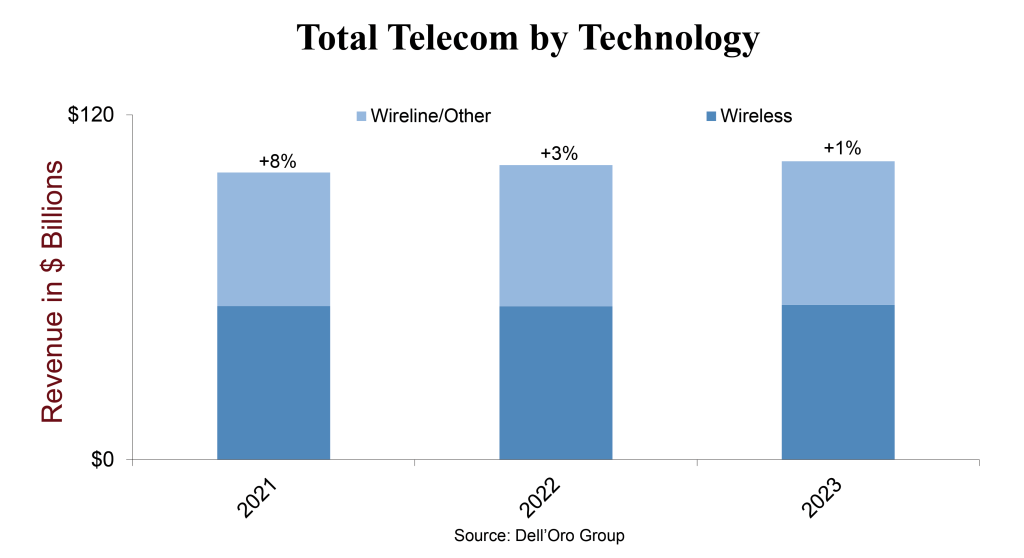
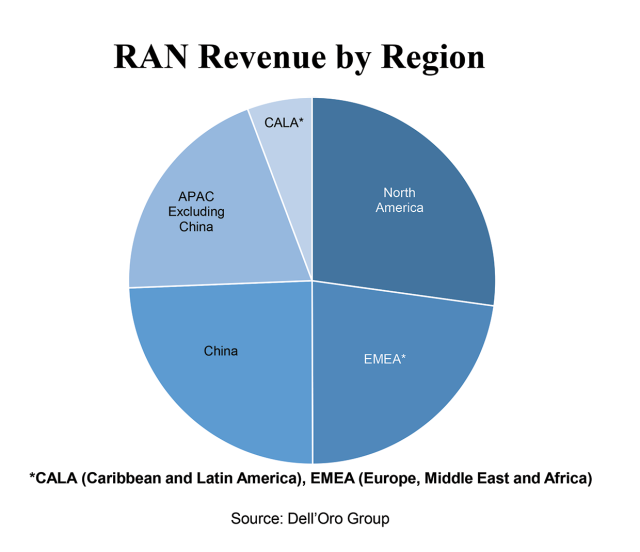
From a technology perspective, there is a bit of capex shift now underway between wireless and wireline. Multiple indicators suggest Broadband Access revenues surged in 2022, however, this double-digit growth was offset by stable or low-single-digit growth across the other five segments (Microwave Transport, Mobile Core Network, Optical Transport, RAN, SP Router & Switch).
Vendor dynamics were relatively stable between 2021 and 2022, with the top 7 suppliers (Huawei, Ericsson, Nokia, ZTE, Cisco, Ciena and Samsung) driving around 80% of the overall market. Despite on-going efforts by the US government to limit Huawei’s TAM and access to the latest silicon, our assessment is that Huawei still leads the global telecom equipment market, in part because Huawei remains the #1 supplier in five out of the six telecom segments we track. At the same time, Huawei has lost some ground outside of China. Still, Nokia, Ericsson, and Huawei were the top 3 suppliers outside of China in 2022, accounting for around 20%, 18%, and 18% of the market, respectively.
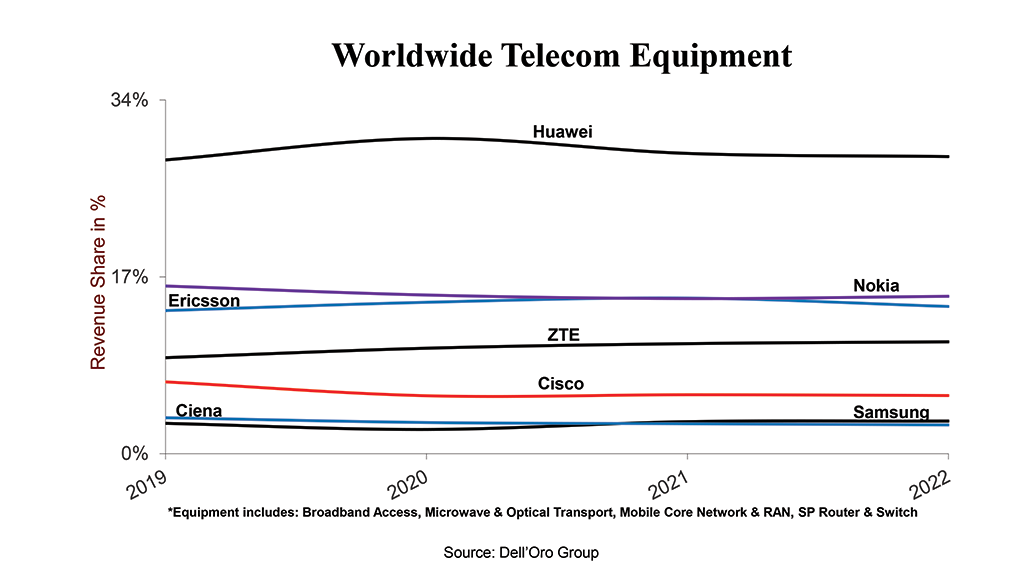
Editor’s Note:
MTN Consulting recently noted that network spending was starting to flatten in the telco segment. In 3Q22, telco capex dipped 5% YoY, the first decline since 4Q20. The vendor market also weakened in 3Q22, as Telco Network Infrastructure (NI) vendor revenues grew just 2% after seven straight quarters of much stronger growth. Now we have a solid set of preliminary results for 2022’s final three months, 4Q22. For the 105 vendors available, Telco NI revenues fell by 1% YoY in 4Q22; this is the first decline for this group of Telco NI vendors since 2Q20, when COVID shut down economies. For CY2022, Telco NI grew just 2% YoY, down from +9% in 2021, when telcos splurged post-COVID, and the 5G RAN market saw a nice run-up. Among the larger reporting vendors, the best 4Q22 Telco NI growth was recorded at the three cloud providers (AWS, Azure, and GCP); engineering services companies Dycom and MasTec; NEPs Calix, Ciena, Samsung, and Technicolor (now Vantiva). New vendor Rakuten Symphony recorded the best overall growth rate in 4Q-2022, with revenues of $180M up 193% YoY. On the other side, Cisco, Ericsson, and ZTE saw the worst declines in 4Q-2022, due in part to a downswing in spending among their largest customers.
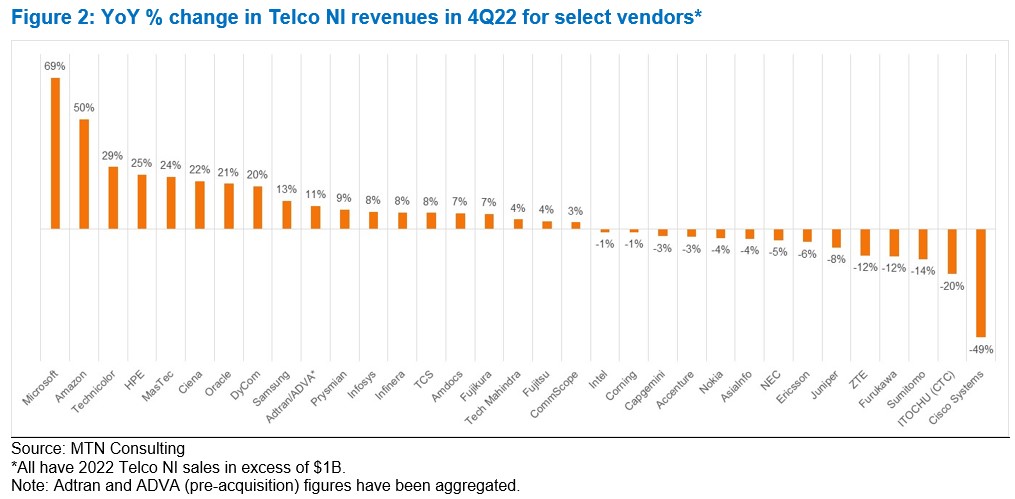
For the overall market, some of the decline seen in 4Q-2022 was inevitable, as telcos slow down their initial 5G network buildouts. Other negatives include higher interest rates, higher energy costs, weak economic growth, cloud alternatives to network builds, and 5G’s inability to deliver services revenue growth. Revenue guidance for 2023 from key vendors suggests a flat to slightly down market, as telcos absorb capacity and continue to wrestle with these challenges. Capex guidance from telcos is consistent.
………………………………………………………………………………………………………………………………………………………………………………………………………………………………………………………………………………………………………….
Following five consecutive years of growth, the Dell’Oro Group believes there is more room left in the tank. Collectively the analyst team is forecasting the overall telecom equipment market to increase 1% in 2023 and record a sixth consecutive year of growth. Risks are broadly balanced and the analysts will continue to monitor the 5G rollouts in India, capex cuts in the US, and 5G slowdown in China (preliminary data by MIIT suggest new 5G BTS volumes will drop by a third in 2023 relative to 2022), wireless and broadband investments in Europe, forex fluctuations, and inventory optimization.
*Telecommunications Infrastructure programs covered at Dell’Oro Group, include Broadband Access, Microwave & Optical Transport, Mobile Core Network (MCN), Radio Access Network (RAN), and SP Router & Switch.
References:
Dell’Oro: PONs boost Broadband Access; Total Telecom & Enterprise Network Equipment Markets
UAE’s “etisalat by e&” announces first software defined quantum satellite network
Dubai’s etisalat by e& today announced the implementation of the Eutelsat quantum satellite solution, becoming the first telco in the country to expand “5G” network capabilities (NOTE: there are no standards for satellite 5G RAN- only for terrestrial RAN, e.g. ITU-R M.2150 and 3GPP Release 15-17) over a software-defined satellite network.
This deployment was a result of rigorous testing with customers for over a year to rapidly scale up the 5G mobile network deployment. etisalat by e& implemented Eutelsat’s latest technology Quantum satellite with the recently installed state-of-the-art Newtech Dialog Hub enhancing the mobile network capability.
“With the demand for ‘always-on’ connectivity as technologies like IoT, AI and blockchain make a bigger impact on consumer lives, satellite connectivity can empower communities and business in this rapidly evolving digital landscape,” said Khalid Murshed, Chief Technology and Information Officer, etisalat by e& UAE. “With the deployment of this satellite solution and technology, our customers will be able to access their data at 5G speeds even when terrestrial connectivity is unavailable, marking another important step towards the regions’ 5G adoption and bridging the digital divide,” he added.

Image Credit: e&, formerly known as Etisalat Group
………………………………………………………………………………………………………………………………………………………………………
“Eutelsat are proud to partner with etisalat by e& to deploy this 5G use case on the world’s first Software Defined satellite network,” said Ghassan Murat, Head of Connectivity Business Unit for Middle East, Africa and Asia Pacific, Eutelsat. “Our fully steerable beams are capable of meeting the most rigorous demands of Next Generation mobile and satellite networks.”
Oscar Garcia, Business Marketing and Product Innovation, etisalat by e&, said, “The need for connectivity has grown beyond traditional communications with customers wanting to access the highest speeds in the network to meet their requirements and demands for bandwidth-intensive applications such as GSM services, Remote IT, Unified communications, OTT, and media streaming among others.. The testing and implementation of this satellite solution greatly enhances the mobile network capability to address the futuristic development of new age applications while being able to build and deploy 5G use cases for various industry verticals and business.”
References:
https://eand.com/en/etisalat-uae.jsp
AST SpaceMobile Deploys Largest-Ever LEO Satellite Communications Array
European Space Agency & UK Space Agency chose EnSilica to develop satellite communications chip for terminals
FCC grants Amazon’s Kuiper license for NGSO satellite constellation for internet services
Bullitt Group & Motorola Mobility unveil satellite-to-mobile messaging service device



